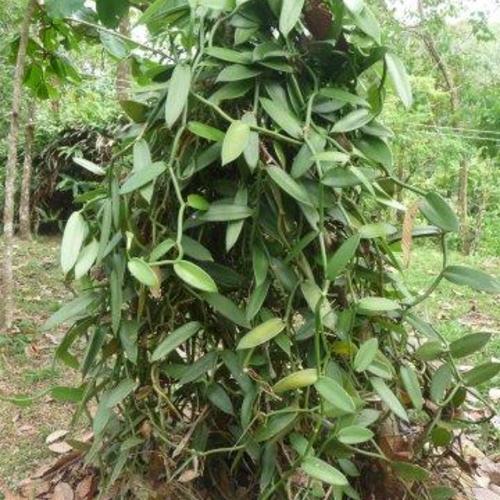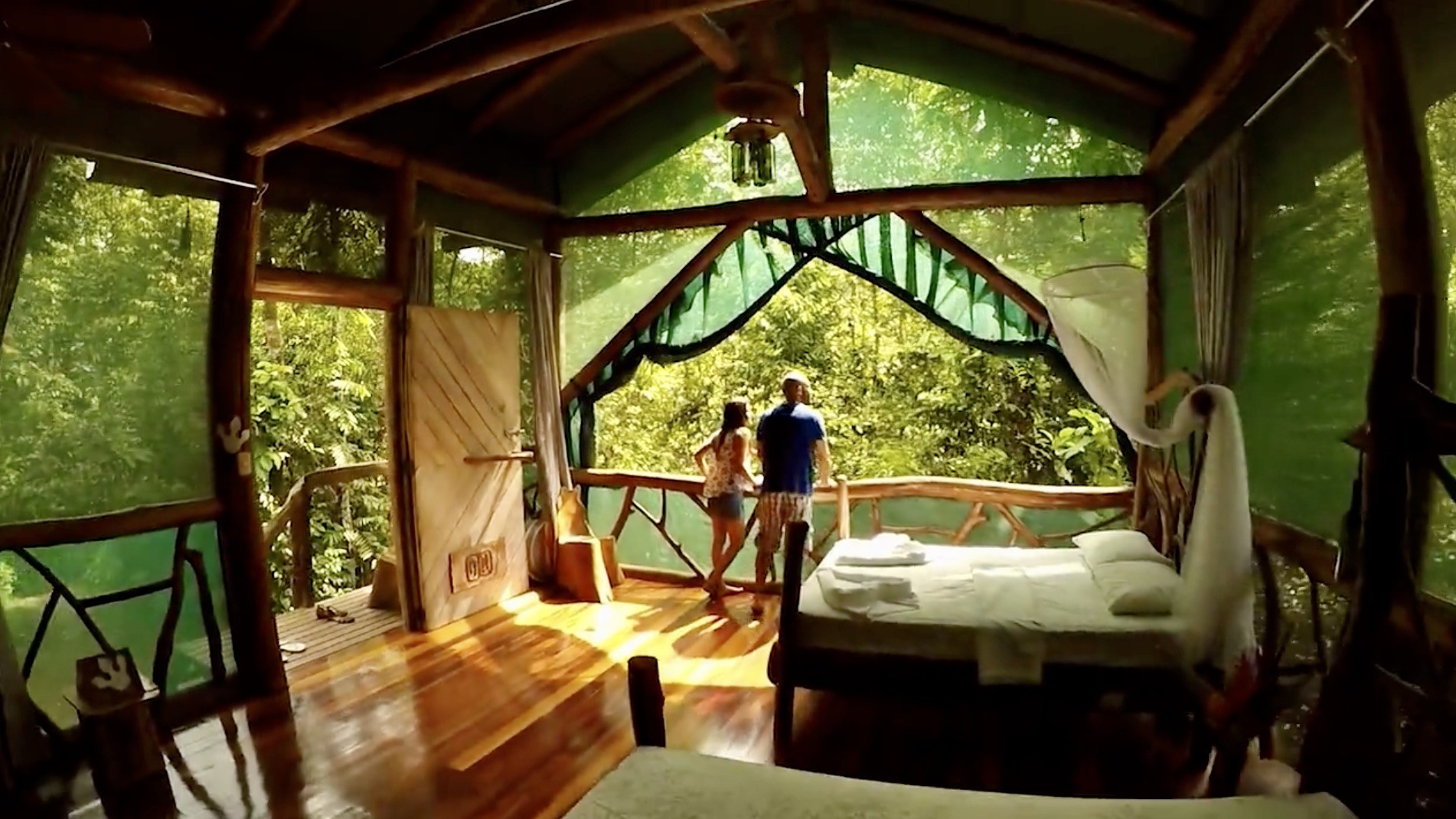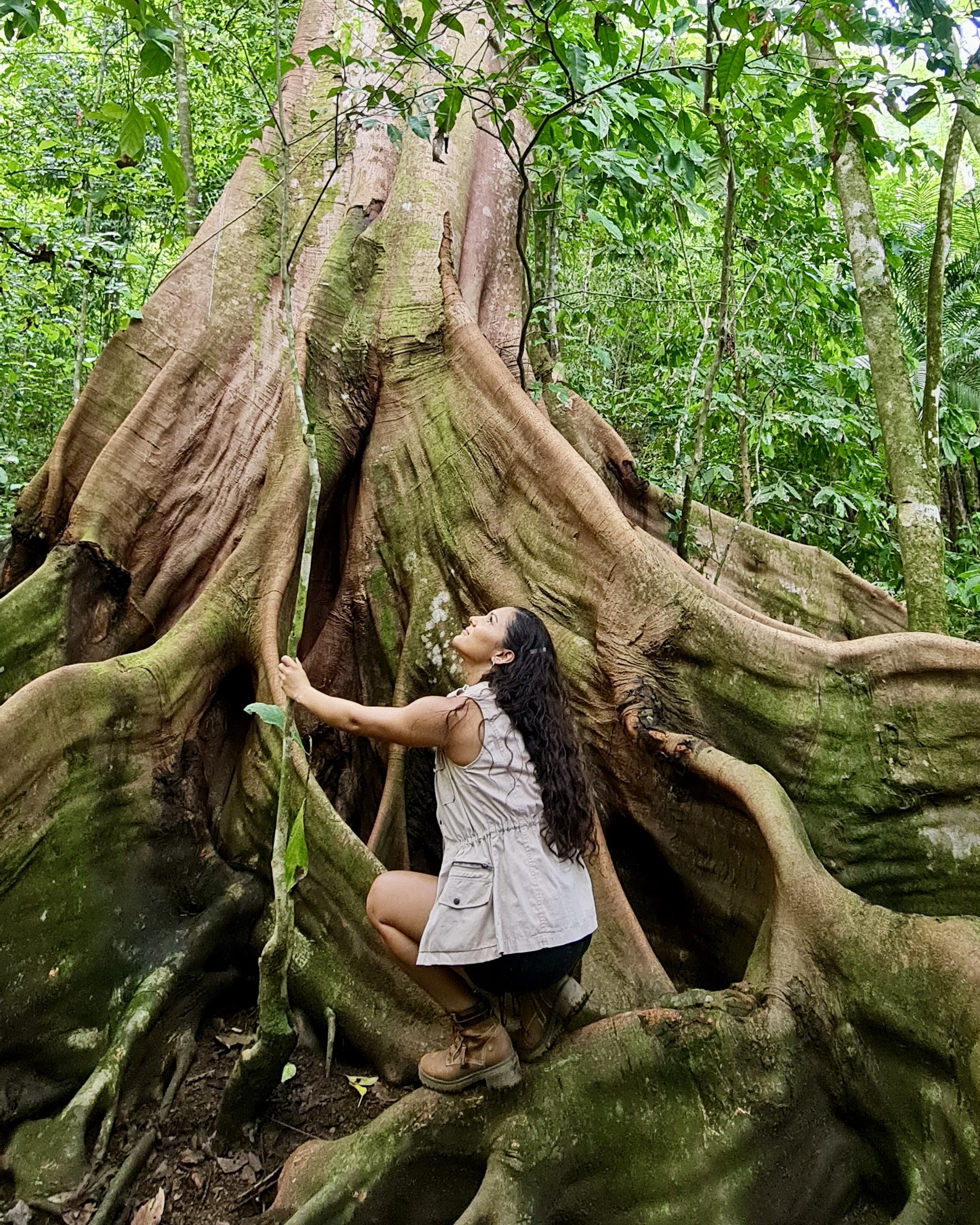
Vanilla comes from the vanilla bean produced from an orchid, which grows up the tree as a vine. Costa Rica has approximately 12 species of vanilla, at least 4 of which are found on the Osa Peninsula. The commercially grown vanilla on the Osa Peninsula is V. planifolia. Pollination of vanilla is very difficult because each flower opens for only 24 hours and must be pollinated within 8-12 hours to produce pods. Due to lack of natural pollinators. pollination is preformed by hand. The top exporters of vanilla are mostly outside of its native range: Madagascar, Indonesia, Mexico, Papau New Guinea, and China. Native to the neotropics, the first people to cultivate vanilla were the Totonacs of Mexico’s east coast.  Vanilla cultivation is on the rise in the Osa Peninsula, and typically produced in an agroforestry system. Currently, many Vanilla species are threatened in the wild. Osa researchers are looking towards wild species of vanilla to test their profitability for commercial production. Vanilla produced in Osa accessible to most and is sold at local supermarkets, at the Osa Cacao Chocolate Factory during their organic farm tours, or on online markets here.
Vanilla cultivation is on the rise in the Osa Peninsula, and typically produced in an agroforestry system. Currently, many Vanilla species are threatened in the wild. Osa researchers are looking towards wild species of vanilla to test their profitability for commercial production. Vanilla produced in Osa accessible to most and is sold at local supermarkets, at the Osa Cacao Chocolate Factory during their organic farm tours, or on online markets here.
Sources:
https://osaconservation.org/vanilla-conservation/
https://osaconservation.org/unexpected-values-vanilla/
https://www.sciencedirect.com/science/article/abs/pii/S0959652621040051
https://vanillasoftheworld.com/products/pure-vanilla-extract-organic-costa-rica
 Cacao on the Osa peninsula is closely tied to the indigenous communities that have lived in the region for centuries. Cacao grows in pods on cacao trees, which can be found in abundance on the Osa. Cacao plantations thrive in the humid, tropical environment. Cacao pods are harvested from the trees and then fermented to enhance their flavor. Following fermentation, the beans are dried, cleaned and roasted. The cacao beans shell is removed, resulting in cacao nibs, which are then ground to create cacao mass. In this grinding process, cocoa butter is released from the nibs, creating a smooth chocolate liquor. Growers on the Osa will either make the final chocolate product on site or the nibs are exported offshore. Chocolate production has been on the rise in the Osa Peninsula due to growing interesting in sustainable techniques of growing. Farmers are increasingly using agroforestry techniques to grow cacao alongside other crops, and many are experimenting with new ways of processing and selling their chocolate. Cacao and chocolate is sold in local supermarkets across the Osa, and on various farms such as Rancho Raices de Puerto Jiménez hold tours to describe the production process to tourists and visitors.
Cacao on the Osa peninsula is closely tied to the indigenous communities that have lived in the region for centuries. Cacao grows in pods on cacao trees, which can be found in abundance on the Osa. Cacao plantations thrive in the humid, tropical environment. Cacao pods are harvested from the trees and then fermented to enhance their flavor. Following fermentation, the beans are dried, cleaned and roasted. The cacao beans shell is removed, resulting in cacao nibs, which are then ground to create cacao mass. In this grinding process, cocoa butter is released from the nibs, creating a smooth chocolate liquor. Growers on the Osa will either make the final chocolate product on site or the nibs are exported offshore. Chocolate production has been on the rise in the Osa Peninsula due to growing interesting in sustainable techniques of growing. Farmers are increasingly using agroforestry techniques to grow cacao alongside other crops, and many are experimenting with new ways of processing and selling their chocolate. Cacao and chocolate is sold in local supermarkets across the Osa, and on various farms such as Rancho Raices de Puerto Jiménez hold tours to describe the production process to tourists and visitors.
Sources:
https://www.osatourism.com/rancho-raices-chocolate-tour/#:~:text=The%20history%20of%20chocolate%20on,a%20medicinal%20and%20ceremonial%20plant.
https://www.whitakerschocolates.com/blog/how-is-chocolate-made-step-by-step/
https://www.tabalchocolate.com/cdn/shop/articles/IMG_2888_2048x.jpg?v=1616340389
 Palm Oil is one of the most profitable products for growers on the Osa. The large seed clusters found underneath the leaves of the palms are harvested and processed into palm oil. Once fruit is harvested, it is put on trucks to processing plants where it is pressed and turned into oil. It is an ingredient found in many food and beauty products, from pizza dough and cookies to soaps and shampoos. It is also a natural substitute of vegetable or coconut oil, and is often a cheaper alternative for people living on the Osa. In the U.S., the average person consumes 17 pounds of palm oil yearly. Palm trees are native to Africa, but can survive in many types of tropical and subtropical climates. The demand for palm oil has resulted in the continued deforestation of native forests on the Osa. Workers are often paid small wages for laborious work on these plantations. However, ecotourism is working to stifle the value of palm oil, making it a less efficient source of profit. It can be purchased at local supermarkets such as Mercado Munipicial de Puerto Armuelles, and in nearly every restaurant or pantry.
Palm Oil is one of the most profitable products for growers on the Osa. The large seed clusters found underneath the leaves of the palms are harvested and processed into palm oil. Once fruit is harvested, it is put on trucks to processing plants where it is pressed and turned into oil. It is an ingredient found in many food and beauty products, from pizza dough and cookies to soaps and shampoos. It is also a natural substitute of vegetable or coconut oil, and is often a cheaper alternative for people living on the Osa. In the U.S., the average person consumes 17 pounds of palm oil yearly. Palm trees are native to Africa, but can survive in many types of tropical and subtropical climates. The demand for palm oil has resulted in the continued deforestation of native forests on the Osa. Workers are often paid small wages for laborious work on these plantations. However, ecotourism is working to stifle the value of palm oil, making it a less efficient source of profit. It can be purchased at local supermarkets such as Mercado Munipicial de Puerto Armuelles, and in nearly every restaurant or pantry.
Sources:
https://greenhawksmedia.net/2020/02/12/investigating-palm-oil-in-costa-rica-over-j-term/
https://news.co.cr/wp-content/uploads/2013/08/Palm-oil-plantation-in-Costa-Rica.jpg
 Rice production on the Osa has declined in the past few decades due to the demand for African Palm. However, it was an historically important crop in the region due to the optimal climate and habitat. Farmers will sell their crops at local markets or partner with companies to make contracts to sell their rice for higher overseas export prices. The seeds are left to mature until they are harvested, washed, de-husked and remove the bran to reveal the white rice that we typically consume. This crop can fluctuate with the patterns of the weather, and profitability of crop yields can be heavily impacted by heavy rains or extreme drought. Rice can be found at markets such as Mini super El 32, Verdulería El mercadito de osa or at restaurants like Rancho Raises de Osa.
Rice production on the Osa has declined in the past few decades due to the demand for African Palm. However, it was an historically important crop in the region due to the optimal climate and habitat. Farmers will sell their crops at local markets or partner with companies to make contracts to sell their rice for higher overseas export prices. The seeds are left to mature until they are harvested, washed, de-husked and remove the bran to reveal the white rice that we typically consume. This crop can fluctuate with the patterns of the weather, and profitability of crop yields can be heavily impacted by heavy rains or extreme drought. Rice can be found at markets such as Mini super El 32, Verdulería El mercadito de osa or at restaurants like Rancho Raises de Osa.
Sources:
https://mucostarica.files.wordpress.com/2011/01/dsc6868.jpg
https://www.google.com/url?sa=t&rct=j&q=&esrc=s&source=web&cd=&cad=rja&uact=8&ved=2ahUKEwjBttHQmoyBAxXPkYkEHWGGCUsQFnoECCIQAQ&url=https%3A%2F%2Fbotanikaresort.com%2Fhistory-of-the-osa-peninsula%2F&usg=AOvVaw3AXm5c9oSsoFRqra_calQy&opi=89978449
 Ecotourism is a key component of the tourism industry in Costa Rica. The immense biodiversity of the country has made it one of the world’s leaders in ecotourism. This type of tourism typically involves activities such as wildlife viewing, hiking, and nature photography, and often focuses on the region’s unique and diverse ecosystems, including its lush tropical rainforests, pristine beaches, and rich marine environments. Thirty years ago, it was uncommon to come across a protected area in the country, now almost 13% of the country is protected within the national parks system. Many eco-lodges and tour operators on the Osa Peninsula offer sustainable tourism experiences that help to support conservation efforts and local communities, while minimizing negative impacts on the environment.
Ecotourism is a key component of the tourism industry in Costa Rica. The immense biodiversity of the country has made it one of the world’s leaders in ecotourism. This type of tourism typically involves activities such as wildlife viewing, hiking, and nature photography, and often focuses on the region’s unique and diverse ecosystems, including its lush tropical rainforests, pristine beaches, and rich marine environments. Thirty years ago, it was uncommon to come across a protected area in the country, now almost 13% of the country is protected within the national parks system. Many eco-lodges and tour operators on the Osa Peninsula offer sustainable tourism experiences that help to support conservation efforts and local communities, while minimizing negative impacts on the environment.  Tourism has helped boost the local economy, via coffee consumption, lodging, eating and more. In the Osa Peninsula, many eco-lodges offer educational and cultural experiences that allow visitors to learn about the region’s unique ecosystems and local cultures. These lodges often use locally-sourced materials and employ local staff, providing economic benefits to the surrounding communities. Some examples of these lodges include Bosque Del Cabo EcoLodge on top of Matapalo, Iguana Lodge in Playa Preciosa and, of course, Finca Kobo in Puerto Jimenez.
Tourism has helped boost the local economy, via coffee consumption, lodging, eating and more. In the Osa Peninsula, many eco-lodges offer educational and cultural experiences that allow visitors to learn about the region’s unique ecosystems and local cultures. These lodges often use locally-sourced materials and employ local staff, providing economic benefits to the surrounding communities. Some examples of these lodges include Bosque Del Cabo EcoLodge on top of Matapalo, Iguana Lodge in Playa Preciosa and, of course, Finca Kobo in Puerto Jimenez.
Sources:
https://www.osatourism.com/costa-rica-ecotourism/
https://en.wikipedia.org/wiki/Ecotourism_in_Costa_Rica
https://www.osatourism.com/osa-peninsula-accommodation-location/#rainforest-location/
Hi, this is a comment.
To get started with moderating, editing, and deleting comments, please visit the Comments screen in the dashboard.
Commenter avatars come from Gravatar.